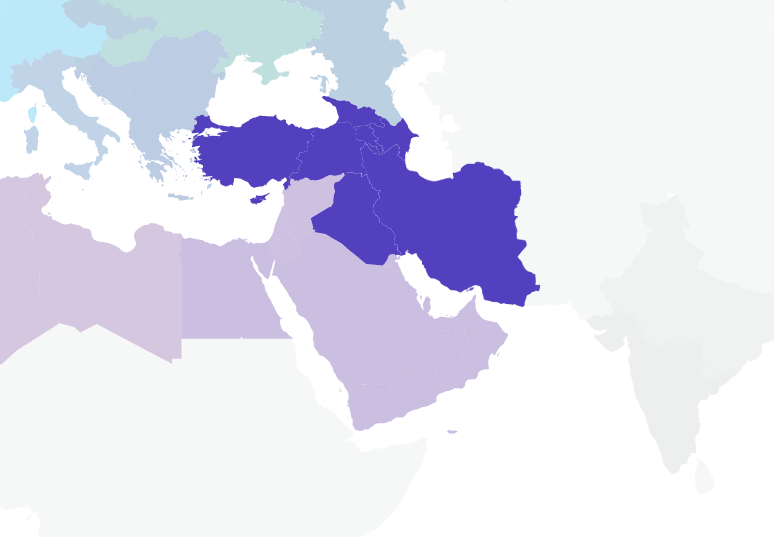ereklebarvამ თემაზე წინაზეც მედავე შენ.
მსოფფლიოში ისეთი საიტები რომელსაც უდიდესი დატაბაზები აქვთ წერენ შემდეგს, რასაც დაბლა დავწერ.
გენეტიკური ტესტით ძალიან ბევრი რამის დადგენა შეიძლება.
ჩემი საიტი სადაც გენეტიკური ანალიზი ჩავიტარე იმას მეუბნება ჩემი მშობლები როდის დაიბადნენ, ასევე ჩემი ბებია, ასევე დიდი ბებია და ა.შ.
ვინც გვახსოვს ყველას დაბადების წლები ემთხვევა.
შენ რისი გჯერა არვიცი. სამეცნიერო ანალიზი ამბობს ამას.
თურქეთი დიდია კი, ბევრი ეთნოჯგუფია მაგრამ ერთ დიდი ეთნოჯგუფთან ვართ დაკავშირებულები.
ჩვენ ყველა რეგიონში მცხოვრები ვიზიარებთ იგივე დნას ისე თუ ასე.
ერთადერთი გ2ა გხვდება ყველაყე ემტად საქართველოში და ეგ იყო ქართული დნა ალბათ მაგრამ ხალხი ერთამნეთშიც ირეოდა და ეს არ არის ცუდი ფაქტი.
პირქით ერტმანეთზე დაქორწინებებს პატარა ერებში მოაქვს შემდგომ გართულებები ჯანრმთელობის მხრივ.
მე თვითონ წარმოშობით აშქენაზი ებრაელიც ვარ მაგრამ აშქენაზებს ძალიან ბევრი გეენტიკური დაავადებები აქვთ სამწუხაროდ და ეს ქნა იმან რომ ებრაელი ებრაელზე ქორწინდებოდა რომ შეენარჩუნებინათ ებრაელობა და ნუ კულტურიდანაც მოდიოდა.
ქართველებს რაც შეეხება მაგ ჩეჩნებისგან გავსხვვადბეით მაგრამ ინტერენტში რამე ნიუსი თუ გამოჩნდება რომ აი დაქორწინდა უცხოელზე დედის გინება მიდის კომენტარებში, ამ გოგოს სამშობლოს მოღალატედ გამოცხადება.
ვერ პატიობენ განსაკუთრებით დაქორწინებას შავკანიანებზე, აზიის ქვეყნებიდან მუსლიმანებზე და ზოგადად აზიელებზე მაგალითად ჩინელებზე.
საემიგრაციო პოლიტიკაც კი ძალიან საშინელი გვაქვს. ეს ნიუსების უმეტესობა ასეთ ოჯახებზე იმიტომ იდება რომ კაცს შვილიც კი ყავს ქართველი ქალისგან და ხან ბინადრობას არ აძლევენ , ხან მოქალაქეობას, მაგრად აწვალებენ.
ახლაც ერთი ქართველი გოგო სირიაშია და ქმარი ვერ მოყავს იმიტომ რომ ვიზას არ აძლევენ. ძალიან კარგი საყვარლეი გოგოა, ძალიან კარგი მეუღლით.
პატარა ერის კომპლექსები გვაქვს ჩვენც, ჩეჩნებსაც უბრალოდ ისინი მაგრად უბერავენ და ექსტრემისტები არიან ტიპები.
ჩეჩნეთში კიდე ნორმალური აზროვნების ვინც იყო ჯერ პუტინმა ამოხოცა, მერე კადიროვმა. ვინც გადარჩა თავს უშველა და მოხია.
ვინც ვერ მოხია და არის ჩუმად.
ეგ რეგიონი ბიდლოების რეგიონად უფრო პუტინმა აქცია.
Northern West Asian
2019-Northern_West_Asian.png
Roughly bounded by Anatolia in the east to Iran in the west, northern West Asia has a shared genetic heritage going back tens of thousands of years. Domestication of grains and livestock emerged 11,000 years ago in this region, sparking the agricultural revolution that spread to parts of Europe, Africa, and other parts of Asia.
Learn more about the history and location of our Arab, Egyptian & Levantine reference datasets, and see the recent ancestor locations included in each.
Anatolian
Anatolia, a fertile peninsula above the eastern Mediterranean, has served as a genetic bridge between Asia and Europe for over 40,000 years. Early Anatolian farmers laid the groundwork for powerful civilizations like the Bronze Age Hittite Empire, followed by centuries of Persian, Greek, and Roman rule. The Eastern Roman Empire, Byzantium, survived in various forms until falling in the 15th century to the Ottoman Turks, who introduced a Central Asian-like genetic signature.
The Anatolian population has Turkey (western provinces) as a recent ancestor location.
Cypriot
An 11,000-year-old settlement on Cyprus’s southern coast was home to some of the island’s first people who processed grain, made jewelry, and lived with domesticated cats and dogs. By 3,000 years ago, Cypriots were speaking a form of Greek, which remains the language spoken across half of the island, even after long periods of Egyptian, Persian, Venetian, Ottoman, and British rule. In spite of a 1974 attempt to annex Cyprus to Greece and an invasion of the island by Turkish forces in response, most Greek and Turkish-speaking Cypriots remain genetically similar to one another.
Iranian, Caucasian & Mesopotamian
From Armenians and Assyrians to Kartvelians and Persians, the diverse people of Iran, the Caucasus, Eastern Anatolia, and Mesopotamia share an ancient genetic history dating back to some of the world’s first farmers. Dominated at times by polytheistic, Zoroastrian, Christian, and Islamic beliefs, the region has seen powerful empires come and go. While most of this ancestry is native to western Asia, traces of Central and East Asian-like genetic signatures were introduced as a result of Turkic migrations and the 13th-century Mongol invasion. Today, there are significant Armenian, Iranian, and Assyrian communities around the world, including many in the United States.
The Iranian, Caucasian & Mesopotamian population has the following recent ancestor locations:
Armenia
Azerbaijan
Georgia
Iran
Iraq
Turkey (eastern provinces)
Broadly Northern West Asian
Roughly bounded by Anatolia in the east to Iran in the west, Northern West Asia has a shared genetic heritage going back tens of thousands of years. Domestication of grains and livestock emerged 11,000 years ago in this region, sparking the agricultural revolution that spread to parts of Europe, Africa, and other parts of Asia. Broadly northern West Asian DNA matches several specific populations and is difficult to assign to just one.
 https://customercare.23andme.com/hc/en-us/a...lations-Regions
https://customercare.23andme.com/hc/en-us/a...lations-Regionsმაგრამ ეს არანაირად არ ნიშნავს რომ ჩვენ და ირანელები ძალიან ვგავართ ერთმანეთს ან ჩვენ და თურქები ან ერთი ხალხი ვართ. ეს ასე არ არის.
ვიღაცები ვაგავართ კი, მაგრამ უმეტესობა არა.
და როცა ერთი ერის წარმომადგენელი ხარ ეს არის იდენტობა შენი პირველ რიგში, კულტურა და რელიგიაც.
და ქათველები მაგ რეგიონში ერთ-ერთი ყველაზე ცივილიზებული და კულტურული ნაცია ვართ და ასევე დიდი პოტენციალიც გვაქვს მაგრამ გვაზის ათასი მტერი და სამშობლოს მოღალატე პარლამენტში თუ ეკლასიაში.
იმ დღეს მ******ნ დამდგენელი აქ რო დავრეგისტრირდი და კიდე ზემოდან ბეზდელნიკობას ამ ყ**ს დოღში მეც რომ ვპოსტავ © metro123



 ·
·